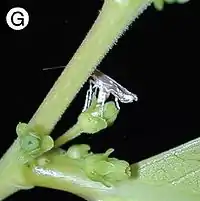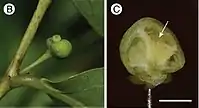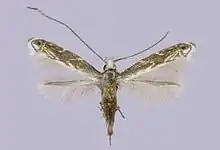Epicephala corruptrix
Epicephala corruptrix is a moth of the family Gracillariidae. It is found on the Ryukyu Archipelago (Amami Island, Tokuno Island, Okinawa Island, Ishigaki Island and Iriomote Island).


| Epicephala corruptrix | |
|---|---|
 | |
| Scientific classification | |
| Kingdom: | |
| Phylum: | |
| Class: | |
| Order: | |
| Infraorder: | |
| Family: | |
| Genus: | |
| Species: | E. corruptrix |
| Binomial name | |
| Epicephala corruptrix Kawakita A, Kato M, 2016 | |
The wingspan is 7.2–8.8 mm. The forewings are brown with a narrow white band on the dorsum from the base to 2/3 of the entire length and with two pairs of narrow white bands beginning at the costal and dorsal margin near 1/2 to 3/4 length of the wing and extending obliquely toward the wing apex, terminating before reaching mid-width of the wing. The dorso-distal band is accompanied by another parallel band of same size on the distal position and there is a narrow silver band with metallic reflection extending from the costa to the dorsum at 5/6 length. The distal 1/6 is orange-brown with a black dot centrally, franked by short white band near the dorsum. The distal end is fringed with a narrow white band. The hindwings are brown.
The larvae feed on the seeds of Glochidion obovatum and Glochidion rubrum.
Etymology
The species name is inherited from Tegeticula corruptrix, a derived parasitic species of yucca moth. Epicephala corruptrix has a potential to corrupt the mutualistic relationship with its host because the species induces gall formation in pollinated flowers which then hardly produce seeds.[1]
References
- Kawakita, Atsushi; Kato, Makoto (23 February 2016). "Revision of the Japanese species of Epicephala Meyrick with descriptions of seven new species (Lepidoptera, Gracillariidae)". ZooKeys. 568: 87–118. doi:10.3897/zookeys.568.6721. PMC 4829671. Retrieved 24 May 2018.